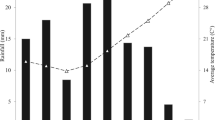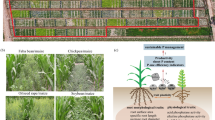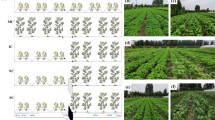Abstract
Purpose
Nitrate (NO3−) leaching has been recognized as a worldwide problem, and NO3− is a major pollutant in ground and surface waters. The gradual leaching of residual NO3− into soil layers below the root zone is the main way of nitrogen (N) loss in cropping systems. The interception of NO3− by subsurface roots is crucial for crops or vegetables to utilize N. However, few studies were focused on the mechanisms of NO3− leaching under intercropping of deep-rooted and shallow-rooted plants.
Materials and methods
In a greenhouse production system, we selected deep-rooted and shallow-rooted plants for single-season intercropping planting experiments (MP, monoculture of pepper; IPA, intercropping of pepper and alfalfa; IPM, intercropping of pepper and maize). Plants were grown in core drainage lysimeters for 4 months, and leachate was collected by soil solution samplers. The results revealed N transformations between monoculture and intercropping systems by comparing NO3− leaching, N use efficiency, and microbes involved in nitrification.
Results and discussion
NO3− accumulation mainly occurred in 25–40-cm soil layer, which was affected by root morphology. Compared with monoculture, intercropping reduced NO3− leaching, in particular, pepper/maize intercropping significantly reduced NO3− leaching losses. In deep soil layers, roots of alfalfa and maize were more developed than those of the other crops, which made this corresponding intercropping system more effective in absorbing N in the subsoil. N uptakes of pepper/alfalfa intercropping and pepper/maize intercropping were 19% and 28% higher than that from the monoculture, respectively. Ammonia oxidizing bacteria (AOB) were significantly stimulated with planting especial in the topsoil, while ammonia oxidizing archaea (AOA) decreased with planting along the soil profile. These results indicated that lush plant roots immobilized N from the deep soil and thus improved N use efficiency and reduced NO3− leaching in the deep-rooted and shallow-rooted intercropping system.
Conclusions
Intercropping of shallow-rooted pepper with deep-rooted alfalfa can enhance root nutrient absorption in deep soil layers, increasing N use efficiency and thus reducing NO3− leaching. The nitrification process in the intercropped soil was mainly regulated by AOB.





Similar content being viewed by others
References
Aghaalikhani M, Gholamhoseini M, Dolatabadian A, Khodaei-Joghan A, Sadat AK (2012) Zeolite influences on nitrate leaching, nitrogen-use efficiency, yield and yield components of canola in sandy soil. Arch Agron Soil Sci 58:1149–1169
Agostini F, Tei F, Silgram M, Farneselli M, Benincasa P, Aller MF (2010) Decreasing nitrate leaching in vegetable crops with better N management. Genetic Engineering, Biofertilisation, Soil Quality and Organic Farming. Springer Netherlands 4:147–200.
Amossé C, Jeuffroy MH, Mary B, David C (2014) Contribution of relay intercropping with legume cover crops on nitrogen dynamics in organic grain systems. Nutr Cycl Agroecosys 98:1–14
Bardgett RD, Mommer L, De Vries FT (2014) Going underground: root traits as drivers of ecosystem processes. Trends Ecol Evol 29:692–699
Baxendale C, Orwin KH, Poly F, Pommier T, Bardgett RD (2014) Are plant-soil feedback responses explained by plant traits? New Phytol 204:408–423
Cavalca L, Zanchi R, Corsini A, Colombo M (2010) Arsenic-resistant bacteria associated with roots of the wild Cirsium arvense (L.) plant from an arsenic polluted soil, and screening of potential plant growth-promoting characteristics. Systematic Appl Microbiol 33:154–164
Chen J, Liu LT, Wang ZB, Sun HC, Zhang YJ, Lu ZY, Li CD (2018) Determining the effects of nitrogen rate on cotton root growth and distribution with soil cores and minirhizotrons. PLoS One 13:0197284
Cong WF, Hoffland E, Li L, Six J, Sun JH, Bao XG, Zhang FS, Van Der Werf W (2015) Intercropping enhances soil carbon and nitrogen. Glob Chang Biol 21:1715–1726. https://doi.org/10.1111/gcb.12738
Coskun D, Britto DT, Shi WM, Kronzucker HJ (2017) Nitrogen transformations in modern agriculture and the role of biological nitrification inhibition. Nature Plants 3:17074
Dai J, Wang Z, Li M, He G, Li Q, Cao H, Wang S, Gao Y (2016) Winter wheat grain yield and summer nitrate leaching: long-term effects of nitrogen and phosphorus rates on the Loess Plateau of China. Field Crop Res 196:180–190
Dambreville C, Hallet S, Nguyen C, Morvan T, Germon JC, Philippot L (2006) Structure and activity of the denitrifying community in a maize-cropped field fertilized with composted pig manure or ammonium nitrate. FEMS Microbiol Ecol 56:119–131
Di HJ, Cameron KC (2016) Inhibition of nitrification to mitigate nitrate leaching and nitrous oxide emissions in grazed grassland: a review. J Soils Sediments 16:1401–1420
Di HJ, Cameron KC, Shen JP, Winefield CS, Callaghan MO, Bowatte S, He JZ (2009) Nitrification driven by bacteria and not archaea in nitrogen-rich grassland soils. Nat Geosci 2:621–624
Di HJ, Cameron KC, Shen JP, Winefield CS, Callaghan MO, Bowatte S, He JZ (2010) Ammonia-oxidizing bacteria and archaea grow under contrasting soil nitrogen conditions. FEMS Microbiol Ecol 72:386–394
Duan W, Shi Y, Zhao J, Zhang Y, Yu ZH (2015) Depth of nitrogen fertiliser placement affects nitrogen accumulation, translocation and nitrate-nitrogen content in soil of rainfed wheat. Int J Plant Prod 9:237-256
Eichler F, Schulz D (1998) The nitrogen reduction program in the Federal Republic of Germany. Environ Pollut 102:609–617
Erisman JW, Sutton MA, Galloway J, Klimont Z, Winiwarter W (2008) How a century of ammonia synthesis changed the world. Nat Geosci 1:636–639
Fan J, Hao MD, Malhi SS (2010) Accumulation of nitrate N in the soil profile and its implications for the environment under dryland agriculture in northern China: a review. Can J Soil Sci 90:423–429
Fan J, Xiao J, Liu DY, Ye GP, Luo JF, Houlbrooke D, Laurenson S, Yan J, Chen LJ, Tian JP, Ding WX (2017) Effect of application of dairy manure, effluent and inorganic fertilizer on nitrogen leaching in clayey fluvo-aquic soil: a lysimeter study. Sci Total Environ 592:206–214
Fan HM, Sun CH, Wen LZ, Liu BW, Ren H, Sun X, Ma FF, Zheng CS (2019) CmTCP20 plays a key role in nitrate and auxin signaling-regulated lateral root development in Chrysanthemum. Plant Cell Physiol 60:1581–1594
Food and Agriculture Organization Statistical Data (FAOSTAT) (2009) Rome, Italy. Available online at: http://faostat.fao.org/site/339/default.aspx
Ge TD, Li BZ, Zhu ZK, Hu YJ, Yuan HZ, Dorodnikov M, Jones DL, Wu JS, Kuzyakov Y (2017) Rice rhizodeposition and its utilization by microbial groups depends on N fertilization. Biol Ferti Soils 53:37–48
Gu BJ, Ge Y, Chang SX, Luo WD, Chang J (2013) Nitrate in groundwater of China: sources and driving forces: human and policy dimensions. Glob Environ Chang 23:1112–1121
Haider G, Steffens D, Moser G, Müller C, Kammann CI (2017) Biochar reduced nitrate leaching and improved soil moisture content without yield improvements in a four-year field study. Agric Ecosyst Environ 237:80–94
Hauggaard-Nielsen H, Ambus P, Jensen ES (2003) The comparison of nitrogen use and leaching in sole cropped versus intercropped pea and barley. Nutr Cycl Agroecosys 65:289–300
Heichel GH, Barnes DK, Vance CP (1981) Nitrogen fixation of alfalfa in the seeding year 1. Cropence. 21:330–335
Hink L, Gubry-Rangin C, Nicol GW, Prosser JI (2018) The consequences of niche and physiological differentiation of archaeal and bacterial ammonia oxidizers for nitrous oxide emissions. ISME J 12:1084–1093
Hinsinger P, Bengough AG, Vetterlein D, Young LM (2009) Rhizosphere: biophysics, biogeochemistry and ecological relevance. Plant Soil 321:117–152
Hu HW, Zhang LM, Dai Y, Di HJ, He JZ (2013) pH-dependent distribution of soil ammonia oxidizers across a large geographical scale as revealed by high-throughput pyrosequencing. J Soils Sediments 13:1439–1449
Hu W, Zhang Y, Huang B, Teng Y (2017) Soil environmental quality in greenhouse vegetable production systems in eastern China: current status and management strategies. Chemosphere 170:183–195
Huang T, Ju XT, Yang H (2017) Nitrate leaching in a winter wheat-summer maize rotation on a calcareous soil as affected by nitrogen and straw management. Sci Rep 7:42247
Huang P, Zhang JB, Zhu AN, Li XP, Ma DH, Xin XL, Zhang AZ, Wu SJ, Garlang G, Pereira ELP (2018) Nitrate accumulation and leaching potential reduced by coupled water and nitrogen management in the Huang-Huai-Hai Plain. Sci Total Environ 610-611:1020–1028
Jussy JH, Colin-Belgrand M, Dambrine E, Ranger J, Zeller B, Bienaime S (2004) N deposition, N transformation and N leaching in acid forest soils. Biogeochemistry 69:241–262
Karpenstein-Machan M, Stuelpnagel R (2000) Biomass yield and nitrogen fixation of legumes monocropped and intercropped with rye and rotation effects on a subsequent maize crop. Plant Soil 218:215–232
Li L, Sun JH, Zhang FS, Guo TW, Bao XG, Smith FA, Smith SE (2006) Root distribution and interaction between intercropped species. Oecologia 147:280–290
Li QQ, Dong BD, Qiao YZ, Meng Y, Zhang JW (2010) Root growth, available soil water, and water-use efficiency of winter wheat under different irrigation regimes applied at different growth stages in North China. Agric Water Manag 97:1676–1682. https://doi.org/10.1016/j.agwat.2010.05.025
Li YF, Hu SD, Chen JH, Muller K, Li YC, Fu WJ, Lin ZW, Wang HL (2018) Effects of biochar application in forest ecosystems on soil properties and greenhouse gas emissions: a review. J Soils Sediments 18:546–563
Liu WX, Ma G, Wang CY, Wang JR, Lu HF, Li SS, Feng W, Xie YX, Ma DY, Kang GZ (2018) Irrigation and nitrogen regimes promote the use of soil water and nitrate nitrogen from deep soil layers by regulating root growth in wheat. Front Plant Sci 9:32
Liu HY, Pan H, Hu HW, Jia ZJ, Zhang Q, Liu YM, Xu JM, Di HJ, Li Y (2019a) Autotrophic archaeal nitrification is preferentially stimulated by rice callus mineralization in a paddy soil. Plant Soil 445:55–69
Liu HY, Ding Y, Zhang QC, Liu XM, Xu JM, Li Y, Di HJ (2019b) Heterotrophic nitrification and denitrification are the main sources of nitrous oxide in two paddy soils. Plant Soil 445:39–53
Liu X, Zhang Y, Ren XJ, Chen BH, Shen CW, Wang F (2019c) Long-term greenhouse vegetable cultivation alters the community structures of soil ammonia oxidizers. J Soil Sediments 19:883–902
Lu XD, Nicol GW, Neufeld JD (2018) Differential responses of soil ammonia-oxidizing archaea and bacteria to temperature and depth under two different land uses. Soil Biol Biochem 120:272-282
Mao L, Zhang L, Li W, Werf W, Sun J, Spiertz H, Li L (2012) Yield advantage and water saving in maize/pea intercrop. Field Crop Res 138:11–20
Pan H, Ying SS, Liu HY, Zeng LZ, Zhang QC, Liu YM, Xu JM, Li Y, Di HJ (2018a) Microbial pathways for nitrous oxide emissions from sheep urine and dung in a typical steppe grassland. Biol Ferti Soils 54:717–730
Pan H, Xie KX, Zhang QC, Jia ZJ, Xu JM, Di HJ, Li Y (2018b) Archaea and bacteria respectively dominate nitrification in lightly and heavily grazed soil in a grassland system. Biol Ferti Soils 54:41–54
Peduruhewa HJ, Gunina A, Tao L, Zhu ZK, Kuzyakov Y, Zwieten LV, Guggenberger G, Shen CC, Yu GH, Singh BP, Pan ST, Luo Y, Xu JM (2020) Rusty sink of rhizodeposits and associated keystone microbiomes. Soil Biol Biochem 147:147. https://doi.org/10.1016/j.soilbio.2020.107840
Prosser JI, Nicol GW (2012) Archaeal and bacterial ammonia-oxidizers in soil: the quest for niche specialization and differentiation. Trends Microbiol 20:523–531
Shen WS, Lin XG, Shi WM, Min J, Gao N, Zhang HY, Yin R, He XH (2010) Higher rates of nitrogen fertilization decrease soil enzyme activities, microbial functional diversity and nitrification capacity in a Chinese polytunnel greenhouse vegetable land. Plant Soil 337:137–150
Shi WM, Yao J, Yan F (2009) Vegetable cultivation under greenhouse conditions leads to rapid accumulation of nutrients, acidification and salinity of soils and groundwater contamination in south-eastern China. Nutr Cycl Agroecosys 83:73–84
Thion CE, Poirel JD, Cornulier T, De Vries FT, Bardgett RD, Prosser JI, Laanbroek R (2016) Plant nitrogen-use strategy as a driver of rhizosphere archaeal and bacterial ammonia oxidiser abundance. FEMS Microbiol Ecol 92:fiw091
Thompson RB, Martínez C, Fernandez MD, Lopez-Toral JR, Gallardo M, Gimenez C (2006) Management factors contributing to nitrate leaching loss from a greenhouse-based intensive vegetable production system. Acta Hortic 700:179–184
Wang JY, Xiong ZQ, Yan XY (2011) Fertilizer-induced emission factors and background emissions of N2O from vegetable fields in China. Atmos Environ 45:6923–6929
Wang C, Lu W, He X, Wang F, Zhou Y, Guo X, Guo X (2016) The cotton mitogen-activated protein kinase kinase 3 functions in drought tolerance by regulating stomatal responses and root growth. Plant Cell Physiol 57:1629–1642
Wang XF, An JP, Liu X, Su L, You CX, Hao YJ (2018) The nitrate-responsive protein MdBT2 regulates anthocyanin biosynthesis by interacting with the MdMYB1 transcription factor. Plant Physiol 178:890–906
Wen B, Li C, Fu X, Li D, Li L, Chen X, Wu H, Cui X, Zhang X, Shen H, Zhang W, Xiao W, Gao D (2019) Effects of nitrate deficiency on nitrate assimilation and chlorophyll synthesis of detached apple leaves. Plant Physiol Bioch 142:363–371
Whitmore AP, SchröDer JJ (2007) Intercropping reduces nitrate leaching from under field crops without loss of yield: a modelling study. Eur J Agron 27:81–88
Wright AN, Wright RD (2004) The Horhizotron: a new instrument for measuring root growth. Hort Technology 14:560–563
Xia WW, Zhang CX, Zeng XW, Feng YZ, Weng JH, Lin XG, Zhu JG, Xiong ZQ, Xu J, Cai ZC, Jia ZJ (2011) Autotrophic growth of nitrifying community in an agricultural soil. ISME J 5:1226–1236
Xu XY, Liu XR, Li Y, Ran Y, Liu YP, Zhang QC, Li Z, He Y, Xu JM, Di HJ (2017) High temperatures inhibited the growth of soil bacteria and archaea but not that of fungi and altered nitrous oxide production mechanisms from different nitrogen sources in an acidic soil. Soil Biol Biochem 107:168–179
Yang XL, Lu YL, Tong YA, Yin XF (2015) A 5-year lysimeter monitoring of nitrate leaching from wheat–maize rotation system: comparison between optimum N fertilization and conventional farmer N fertilization. Agric Ecosyst Environ 199:34–42
Ye XH, Han B, Li W, Zhang XC, Lin XG, Zou HT (2018) Effects of different irrigation methods on nitrous oxide emissions and ammonia oxidizers microorganisms in greenhouse tomato fields. Agric Water Manag 203:115–123. https://doi.org/10.1016/j.agwat.2018.03.012
Ying JY, Li XX, Wang NN, Lan ZC, He JZ, Bai YF (2017) Contrasting effects of nitrogen forms and soil pH on ammonia oxidizing microorganisms and their responses to long-term nitrogen fertilization in a typical steppe ecosystem. Soil Biol Biochem 107:10–18
Zhang X, Chen S, Sun H (2009) Root size, distribution and soil water depletion as affected by cultivars and environmental factors. Field Crop Res 114:75–83. https://doi.org/10.1016/j.fcr.2009.07.006
Zhang J, Yin B, Xie Y, Li J, Yang ZB, Zhang GG (2015) Legume-cereal intercropping improves forage yield, quality and degradability. PLoS One 10(12):0144813
Zhang Y, Lin F, Jin Y, Wang XF, Liu SW, Zou JW (2016) Response of nitric and nitrous oxide fluxes to N fertilizer application in greenhouse vegetable cropping systems in southeast China. Sci Rep 6:20700
Zhang B, Li Q, Cao J, Zhang CY, Song Z, Zhang FS, Chen XP (2017) Reducing nitrogen leaching in a subtropical vegetable system. Agric Ecosyst Environ 241:133–141
Zhang Q, Li Y, He Y, Liu HY, Dumont MG, Brookes PC, Xu JM (2019) Nitrosospira cluster 3-like bacterial ammonia oxidizers and Nitrospira-like nitrite oxidizers dominate nitrification activity in acidic terrace paddy soils. Soil Biol Biochem 131:229–237
Zhou J, Gu B, Schlesinger WH, Ju XT (2016) Significant accumulation of nitrate in Chinese semi-humid croplands. Sci Rep 6:25088
Zhu ZL, Chen DL (2002) Nitrogen fertilizer use in China–contributions to food production, impacts on the environment and best management strategies. Nutr Cycl Agroecosys 63:117–127
Zhu LX, Zhang WJ (2017) Effects of controlled-release urea combined with conventional urea on nitrogen uptake, root yield, and quality of Platycodon grandiflorum. J Plant Nutr 40:662–672
Funding
This study was supported by National Key R&D Program of China (2017YFD0800404, 2016YFD0200302), National Natural Science Foundation of China (41671249), and Fundamental Research Funds for the Central Universities (2019QNA6011).
Author information
Authors and Affiliations
Corresponding author
Ethics declarations
Conflict of interest
The authors declare that they have no conflict of interest.
Additional information
Responsible editor: Yuan Ge
Publisher’s note
Springer Nature remains neutral with regard to jurisdictional claims in published maps and institutional affiliations.
Electronic supplementary material
ESM 1
(DOC 557 kb)
Rights and permissions
About this article
Cite this article
Ding, Y., Huang, X., Li, Y. et al. Nitrate leaching losses mitigated with intercropping of deep-rooted and shallow-rooted plants. J Soils Sediments 21, 364–375 (2021). https://doi.org/10.1007/s11368-020-02733-w
Received:
Accepted:
Published:
Issue Date:
DOI: https://doi.org/10.1007/s11368-020-02733-w




